XALA Geschichte
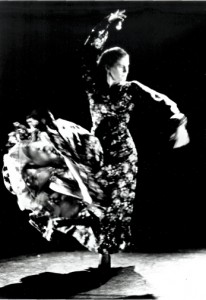 As a flamenco dancer and a rhythmic artist Ania Losinger has dedicated herself wholeheartedly to the fascinating undertaking of committing her entire body to the process of musical creation. The specially prepared wooden sounding board she dances upon becomes a membrane for her, the movements of her flamenco shoes with their associated footwork correspond in many ways to those of a drummer. The idea of becoming at the same time a dancer and musician becomes increasingly important. Through collaboration with Don Li she begins to find a new orientation both musically and in dance. She builds herself a dancing platform of different kinds of wood and metal plates (in part with the addition of sound pickups) and plays rhythmical patterns composed by Don Li on it.
As a flamenco dancer and a rhythmic artist Ania Losinger has dedicated herself wholeheartedly to the fascinating undertaking of committing her entire body to the process of musical creation. The specially prepared wooden sounding board she dances upon becomes a membrane for her, the movements of her flamenco shoes with their associated footwork correspond in many ways to those of a drummer. The idea of becoming at the same time a dancer and musician becomes increasingly important. Through collaboration with Don Li she begins to find a new orientation both musically and in dance. She builds herself a dancing platform of different kinds of wood and metal plates (in part with the addition of sound pickups) and plays rhythmical patterns composed by Don Li on it.
It is during this time that she first becomes aware of the fact that the particular phrasing that is created by the interplay of weight and balance and the dancing of repetitive rhythms, yields her own, personal music .
From this awareness, the vision of an acoustic sounding floor which produces vibrant and tuned sounds that react to dynamic of movements and strokes, springs forth. The form of this sounding floor develops in collaboration with Hamper von Niederhäusern (1997-99).
After building several prototypes he produces sounding boards which are attached to a framework and which can carry the weight of a human body yet still produce sounds – the first XALA. While playing on the Xala with her flamenco shoes and man-high poles, Ania Losinger can visualize the music and inspire her audience to listen ever more intensely.
Self-portrayal in dance and in musical virtuosity is eliminated in favor of coordination, sensuality, precision, permeability, tension and concentration, which make the danced music resonate. The limitations in range, the individual characteristics of certain sound boards, the spatial limitations in reference to dance have an extremely positive effect on Ania’s personal artistic expression.
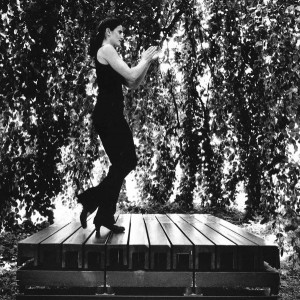 In 1999 the first solo performance (“Soneto“) is developed for the Xala I in collaboration with Christian Mattis, and performed in Switzerland, Germany and Italy. In 2001 Ania Losinger produces her first XALA-Solo-CD-Rom “Ania Losinger XALA” together with Swiss Radio DRS2 and Don Li. She appears under the label Tonus-Music-Records, whose products are marketed in many countries throughout the world.
In 1999 the first solo performance (“Soneto“) is developed for the Xala I in collaboration with Christian Mattis, and performed in Switzerland, Germany and Italy. In 2001 Ania Losinger produces her first XALA-Solo-CD-Rom “Ania Losinger XALA” together with Swiss Radio DRS2 and Don Li. She appears under the label Tonus-Music-Records, whose products are marketed in many countries throughout the world.
Immediately afterwards Hamper von Niederhäusern and Hanspeter Ehrsam added microphones to the entire instrument (Xala I) This entailed adding a pick-up with relative preamplifier to each of the 24 tones. With my digital mixer it is possible to finely tune each note by electronically accentuating particular frequencies and adding effects.
The Xala combines a mixture of archaic and highly developed technical knowledge in its method of construction, its amplification and the techniques used when playing it. In addition to Ania Losinger’s own research on this new instrument, Don Li influences her style of playing through his compositions. On the other hand, the Xala itself, both as acoustic and visual instrument also significantly influences his compositions.
This fruitful interaction leads not only to the productions with Xala as solo instrument such as Don Li’s Speech-Pattern-Compositions “The Longest Journey” in New York 02, “Time-Experience” for the Jazzfestival in Willisau 03 and Jazzfestival Cully 04, but also to the one hour long composition “tonus-music” for XALA and symphony orchestra, directed by Kaspar Zehnder which premiered with great success in the Casino Theatre in Berne.
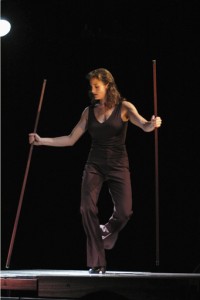 The solo live-performance “Ania Losinger XALA” is performed in all of Europe.
The solo live-performance “Ania Losinger XALA” is performed in all of Europe.
As a further documentation of the Xala the first XALA-Sound-/ Photo (DVD) is released which focuses more on the visual aspects of this sounding floor. For this purpose Don Li wrote a one hour electronic surround composition for Xala and string quartett. (“New Ballet for XALA“).
Pierre-Yves Borgeaud (winner of the Golden Leopard 03 in Locarno for video) takes on the direction of the film. His idea is to take advantage of the rarely used multi-angle technique for this film. This allows viewers to choose from interactive perspectives and image areas as the surround-music plays. The live-performance of “New Ballet for Xala” was viewed by audiences at the Jazzfestival Schaffhausen 05, the Minimal-Music Festival in Kassel 05, BE Jazzfestival ir Bern 06 and in the USM-showroom in Manhattan NY 05.
Thanks to the first concert tours and parallel to requests for workshops and seminars for teachers in music conservatores and music schools (Trossingen DE, Bern, Aargau, Solothurn) Hamper von Niederhäusern received contracts to build permanent Xala installations made of stone, metal and wood for educational institutions and social therapy centers. In time, not only the artistic potential of this instrument is recognized but also its therapeutic and educational potential.
The new Xala (The Xala II) is completed in February of 2004. All the experience that Ania Losinger and Hamper von Niederhäusern have aquired has led to improvements in the quality of the sound spectrum, the fine-tuning of the overtones, the order of the notes and ease of transportation.
Ania Losinger begins an intense collaboration with the musician and composer Mats Eser (marimba/percussion). In 2005 their first joint composition “The Five Elements” is produced. The focus point of this five-piece concert performance is Ania Losinger’s Xala II and Mats Eser’s five-octave marimba. With this debut they immediately are able to create a distinct tonal universe that sparks enthusiasm in audiences and organizers both at home and abroad. (Festivals and concerts in Switzerland, Germany, Russia, Finland, Holland, Poland, Italy).
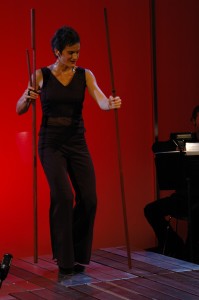 In 2007 Ania and Mats develop a concert performance for children and young adults commissioned by the city theatre in Winterthur, titled “Beat, Ready and go!” This performance contains first elements of music-theatre. Together with actor and director Clo Bisaz they adapt the famous fairy-tale “Cinderella”. The instruments that are developed especially for this performance are at the same time stage props made of sounding objects and the electro-acoustic danceable sounding floor TM-Xala (TM means Tanzmeter (Dance meter). After 2008 “Cinderella” tours the whole of Europe. In 2009 “To the Beat of the Times” premieres and their first music for film is composed for the documentary “DIARIOS CINETICOS de una escultura de Angel Duarte” by Carlos Lügstenmann.
In 2007 Ania and Mats develop a concert performance for children and young adults commissioned by the city theatre in Winterthur, titled “Beat, Ready and go!” This performance contains first elements of music-theatre. Together with actor and director Clo Bisaz they adapt the famous fairy-tale “Cinderella”. The instruments that are developed especially for this performance are at the same time stage props made of sounding objects and the electro-acoustic danceable sounding floor TM-Xala (TM means Tanzmeter (Dance meter). After 2008 “Cinderella” tours the whole of Europe. In 2009 “To the Beat of the Times” premieres and their first music for film is composed for the documentary “DIARIOS CINETICOS de una escultura de Angel Duarte” by Carlos Lügstenmann.
„Aschenputtel“ tourt ab 2008 in ganz Europa. 2009 folgt die
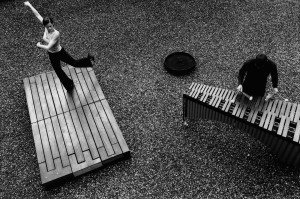 In the premiere of the work for orchestra “Tonus-Music for Xala, Marimba and Orchestra” 2008 in Burgdorf directed by Bruno Stöckli the Xala I is once again played. The CD production “The Five Elements” Vol. 1 with Xala II and marimba/percussion is released in 2009 in Switzerland, Germany and Austria. A CD release tour througout Europe follows.
In the premiere of the work for orchestra “Tonus-Music for Xala, Marimba and Orchestra” 2008 in Burgdorf directed by Bruno Stöckli the Xala I is once again played. The CD production “The Five Elements” Vol. 1 with Xala II and marimba/percussion is released in 2009 in Switzerland, Germany and Austria. A CD release tour througout Europe follows.
Ania Losinger and Mats Eser are protagonists in the Swiss film “Bödälä-Dance the Rhythm” directed by Gitta Gsell, which premieres in January of 2010 at the Solothurner Filmtagen film festival, wins the audience prize and then is shown in cinemas throughout Switzerland. After further film festivals such as Locarno and München the film is shown in theatres in Germany and Austria.
At the beginning of 2010 Ania Losinger, Mats Eser and Hamper von Niederhäusern develop the Xala III. The Xala III is for the first time a airworthy instrument which can be taken apart and packed into five cases. It functions electroacustically and is a synthesis of Xala II and Dancemeter. In the summer of 2010 the duo Losinger-Eser flies to Shanghai with their instrument for the first time to take part in the World Exposition and play their new program “fú-danced Soundsculptures” (Xala III and Minimal-Percussion) in the Spanish pavillion for three weeks.
Performances at home and abroad follow as well as a new premiere “Shanghai Patterns” (SF 10vor10 Swiss News) played on Xala III and marimba/percussion during the BE Jazz Winterfestival in Berne. In 2012, the premiere of “Scope” with the Xala III and Fender Rhodes takes place in the Franz Gertsch museum in Burgdorf.
In 2014 the CD Trilogy with Xala III (Fú, Shanghai Patterns, Scope) is released.
In 2015 Ania Losinger and Mats Eser, together with Björn Meyer and Chrigel “Tian” Bosshard, found the band NEN [e]merging structures – hypnotic soundscapes. NEN plays at festivals and in clubs in Switzerland, Germany and Italy. The music of this band is published on Bandcamp.
The premiere of the composition “Music for an Open Space” took place at the Festival for European Church Music in Schwäbisch Gmünd in 2017. Since the duo’s first work “The Five Elements” this is the first composition for the purely acoustic instruments Xala II and Marimba / Percussion.
In 2018, this acoustic piece for Xala, Marimba and Orchestra premiered as “Open Space Suite”.